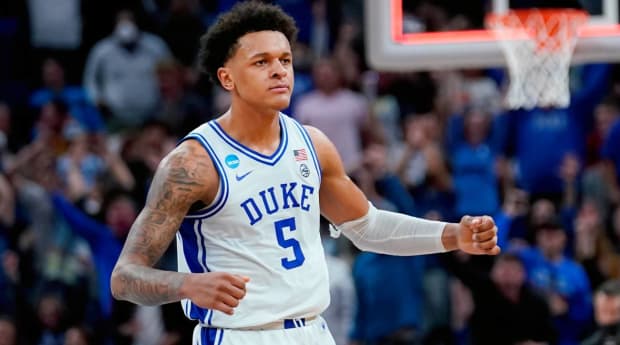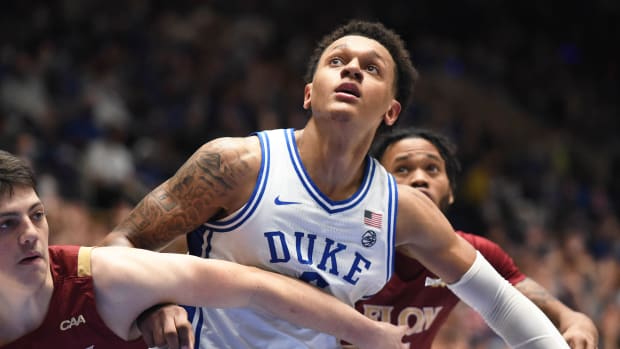Seattle is proud of its underrated hoops heritage. Banchero is poised to be the city’s best and most beloved basketball export.
SEATTLE – For Jason Kerr, the screensaver on his desktop monitor is one of few reminders from the magical state championship season in 2019. Those are his O’Dea basketball players smiling in the photo. That’s a future NBA lottery pick, the one he coached and mentored, in the bottom left corner of the frame.
The kid looks the same in the image as he does this spring on television, right down to the No. 5 stitched onto his jersey and the impenetrable gaze of quiet confidence. He’s smaller and younger in the photo, and yet, it’s unmistakably him, too. That’s Paolo Napoleon James Banchero, the Duke forward, same tall-and-lithe frame, same flexed biceps, same curly black hair. He’s 16 years old in the photo and 19 now. And his push for another championship continues Saturday, when Duke clashes with North Carolina in the Final Four. The symmetry is not surprising; it’s all part of the same plan, a life pointed long ago toward stardom, magical seasons and games the sports world stops to watch. Only the stage and stakes are different now.
As this NCAA tournament continued and Banchero willed Mike Krzyzewski’s final season toward a fairy tale ending, his last coach before Krzyzewski marveled at the duality involved. So much had changed … and nothing really had. Kerr didn’t want to burden Banchero with much advice, but he did pass along something he learned in that 2019 season. When O’Dea triumphed, Kerr spun in every direction, bouncing from interviews to handshake lines, doing everything except what he now wishes he had done first. “I missed the whole celebration,” he says. Hence the picture on his desktop monitor, along with the text message he sent Banchero last week.
Enjoy the heck out of it, Kerr wrote.

Marcio Jose Sanchez/AP
On Tuesday morning, Kerr sits behind a wide desk inside his office. He’s surrounded by Seattle hoops history and concrete walls. Like everyone else at O’Dea, a Catholic high school with roughly 500 students located near downtown in the neighborhood known as First Hill, he’s experiencing a little Banchero-related déjà-vu.
He turns on some film from Banchero’s junior season and sits up straighter, memories returning, along with did-he-really-do-that exclamations. The stands are packed, signaling that this game took place before the global pandemic. O’Dea is playing Garfield, another local power in a sneaky national hoops hotbed, once home to future NBA players Brandon Roy, Will Conroy, Tony Wroten and Jaylen Nowell. There’s Banchero, set up out on the wing, calling for the ball. He drives and scores, grabs a steal and knocks down a three-point attempt—five points in a handful of seconds, along with a quick flex. “He’s kinda shy,” Kerr says. “But he had that personality. You see it mostly when he’s around his friends.”
Kerr still remembers when Banchero arrived at O’Dea. His background—both parents played Division I sports in college—hinted at immense promise that started with good genes. The Bancheros met at nearby University of Washington, where Mario Banchero played tight end and Rhonda Smith set the all-time scoring mark for the Huskies’ women’s basketball program, before playing in the WNBA. It’s not that Kerr was wary of the hype that blanketed Banchero. It’s that, as a longtime fixture on the Seattle basketball scene, he understood there was no shortage of elite players. Before taking a sabbatical to spend more time at home with his young children, Kerr coached for 14 seasons and won three state titles at Franklin High, home to Jason Terry, Aaron Brooks and Peyton Siva. He wanted to see this Banchero for himself.
Banchero revealed his skills immediately, early into his freshman season, along with something more important: the drive that separated great players from future pros. “Keep this up, and you’re going to be ridiculous,” Kerr told him. Then, to his assistants, he said, “Knock on wood, we’re going to be watching him play for a long time.”
Kerr pauses the film, momentarily, to take another detour. “See that,” he says, pointing to Banchero in the post, calling for the ball. “We needed him to score in a lot of different ways.”
As a high school freshman, Banchero was already nearing his current height of 6-feet, 10-inches. But because he towered over most other players, his youth coaches deployed him mostly in the post. At heart, he thought of himself more as a guard. So he set out to develop an all-around game tailored to the modern NBA, where centers and forwards move like smaller players, set up all over the court and spin, drive and twist their way over defenders or right past them.
For his first three seasons, Banchero took deliberate steps to overhaul his overall game. He could already pass well; in fact, his court vision came so naturally that Kerr encouraged him to distribute less. Banchero began his evolution by focusing on playing at a faster tempo, which meant higher levels of conditioning so he never tired and never came out. Next, he focused on ball handling, because he already grabbed rebounds easily and reasoned that if he could dribble down court, he wouldn’t need to whistle an outlet pass to start the break. Next: perimeter shooting, which he honed through thousands of practice attempts, adding moves to his repertoire until he could create his own shot through more than his size alone.
Each step added up to something greater: a fluidity that defined his game. Banchero entrances with movement as much as anything; every step smooth and intentioned, the teen himself graceful and in balance despite carrying 250 pounds on his no-longer-lean frame.
What struck Kerr wasn’t that Banchero improved but how consciously Banchero went about improving. He came from a basketball family and never left the basketball court. That led to the quiet confidence and the play that unspools next on Kerr’s computer. There’s Banchero, fluid and smooth, jumping straight up to block an opponent’s shot with such force that the ball flies into the stands. The home crowd rises, delirious, as Kerr notes his star “got away with a little push afterward.” There’s the fire, and the resemblance, then so much like now.

Rob Kinnan/USA TODAY Sports
It’s uncanny, this highlight reel of pull-up jumpers, spin moves, fadeaways and drives. It’s what drew Duke to recruit Banchero and what pushed Banchero to play for Krzyzewski in the coach’s final season. There was pressure inherent in his choice: a cross-country move, stakes raised from the farewell tour, young team, tough conference, plenty of development remaining. Banchero embraced it all. He wanted the burden, which he didn’t see as a burden, because he wanted to improve. As Kerr watched Banchero’s body fill out, he saw that same drive, an “unwillingness to cower.” When television cameras captured Banchero winking late in one victory, Kerr knew. The takeover was coming next. Asked why, what tipped him, the coach shrugs. “He’s used to these types of things,” Kerr says.
Indeed. Banchero’s lone college hoops season opened at Madison Square Garden, against powerhouse Kentucky, in front of dozens of talent evaluators. He had not yet turned 19, and yet, he exuded poise, that grace. This wasn’t Zion Williamson dunking his way into the national sports consciousness. It was more subtle with Banchero, but no less eye-catching or effective overall. LeBron James posted about his shoes afterward.
Two weeks later, Banchero and Duke knocked off top-ranked Gonzaga. One scout in attendance noted how the freshman could “score at all three levels.” Just like on the film in Kerr’s office, only it was translating in college, against better players. He scored 21 points and knocked around Chet Holmgren, another tall, talented potential No. 1 overall pick.
It wasn’t perfect; there were missteps. Banchero was cited for aiding and abetting DWI after an early-season win over The Citadel, an incident he said he “learned from.” Duke, meanwhile, lost twice in four games in early January and worse yet, dropped Krzyzewski’s home finale, his final game as a head coach in Cameron Indoor Stadium, to rival UNC.
Throughout, Banchero provided consistency that belied his age—same as always, according to Kerr. Only 19, he averaged 17.1 points, 7.7 rebounds and 3.2 assists. He made 47.8 percent of his shots, too, making him not only lethal but efficient. Opponents struggled with an unsolvable riddle. How would they guard him? Most bigs were too slow; most non-bigs were too small. Coaches began to double him, but that only opened space for Duke’s other scoring options, of which there are many. Banchero’s natural passing ability led to easy baskets, as he played like a forward- or center-sized guard. “He’s all in,” Krzyzewski said by late February, citing his forward’s improvement under assistant coach Jon Scheyer.
The development continued. Banchero utilized his frame to get closer to the basket, drawing fouls and, as Coach K told him, “impose my will.” That made Banchero even harder to guard, started comparisons to players like Carmelo Anthony and positioned Duke for a No. 2 seed in this NCAA tournament. Many tabbed the Blue Devils for an early upset. Most of those who doubted them did not know Banchero. In the NCAA tournament, Kerr says he “elevated to another level.” That meant 17 points, 10 boards and four assists against Cal State Fullerton; 19-7-4 against Michigan State; 22 points, four assists and three steals against Texas Tech; and 16 points, seven rebounds, three assists, one steal and one block against Arkansas. Banchero termed his performance the past few weeks as “a step,” the next one, nothing more.
“We just stuck together through it all,” Banchero told reporters when asked about his freshman season after the Blue Devils’ victory in the Elite Eight. He relayed a story from his childhood, about his mom and a state title she won as a coach, and how when he saw her atop a ladder, cutting off a piece of the net, he knew he wanted to do the same. He was disappointed when, after O’Dea triumphed, officials lowered the hoop, meaning the players didn’t need a ladder and “it kind of ruined the moment a little bit.” When he climbed an actual ladder in San Francisco, he looked into the crowd, saw his mom and told her to take a video and snap pictures. He wanted to remember his net cutting forever, too. “That’s good,” Krzyzewski said, sitting next to him, having just passed John Wooden for Final Four appearances, with 13. “That’s really good.”
On Saturday, Kerr will host about 25 friends and family members at his home in Seattle. They might lament how the city still hasn’t gotten another NBA team after the Sonics left. They might debate where Banchero will fall in the draft. They will not, under any circumstances, mess up his perfectly manicured lawn, the place where “I do my best thinking,” Kerr says.
The assembled also won’t doubt Banchero. They long ago learned not to. Instead, they will celebrate the kid from the family of athletes who knew what he wanted and worked toward his aims in very specific ways. They will remember the state title run before the national championship echoes started. And they will root for the phenom who’s easy to root for, despite success that can seem predestined. He is one of theirs, after all: a member of the O’Dea Fighting Irish, part of a grand local basketball tradition and, perhaps, the star who might deliver Krzyzewski the perfect end to a storied career. Not bad for one lone season of college hoops.
More CBB Coverage: